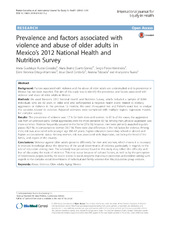| dc.contributor.author | Ruelas-González, Maria Guadalupe | en_US |
| dc.contributor.author | Duarte-Gómez, María Beatriz | en_US |
| dc.contributor.author | Flores-Hernández, Sergio | en_US |
| dc.contributor.author | Ortega-Altamirano, Doris Veronica | en_US |
| dc.contributor.author | Cortés-Gil, Jesus David | en_US |
| dc.contributor.author | Taboada, Arianna | en_US |
| dc.contributor.author | Ruano, Ana Lorena | en_US |
| dc.date.accessioned | 2020-08-06T10:32:52Z | |
| dc.date.available | 2020-08-06T10:32:52Z | |
| dc.date.issued | 2016 | |
| dc.Published | Ruelas-González, Duarte-Gómez, Flores-Hernández, Ortega-Altamirano, Cortés-Gil, Taboada, Ruano. Prevalence and factors associated with violence and abuse of older adults in Mexico’s 2012 National Health and Nutrition Survey. International Journal for Equity in Health. 2016;15:35 | eng |
| dc.identifier.issn | 1475-9276 | |
| dc.identifier.uri | https://hdl.handle.net/1956/23510 | |
| dc.description.abstract | Background: Factors associated with violence and the abuse of older adults are understudied and its prevalence in Mexico has not been reported. The aim of this study was to identify the prevalence and factors associated with violence and abuse of older adults in Mexico. Methods: We used Mexico’s 2012 National Health and Nutrition Survey, which included a sample of 8,894 individuals who are 60 years or older and who self-reported a negative health event related to robbery, aggression or violence in the previous 12 months. We used chi-squared test and Fisher’s exact test to analyze the variables related to violence. Adjusted estimates were completed with multiple logistic regression models for complex surveys. Results: The prevalence of violence was 1.7 % for both men and women. In 95 % of the cases, the aggression was from an unknown party. Verbal aggressions were the most prevalent (60 %). Among men, physical aggression was more common. Violence frequently occurred in the home (37.6 %); however, men were primarily assaulted in public places (42.4 %), in comparison to women (30.7 %). There were also differences in the risk factors for violence. Among men, risk was associated with younger age (60–64 years), higher education (secondary school or above) and higher socioeconomic status. Among women, risk was associated with depression, not being the head of the family, and region of the country. Conclusions: Violence against older adults presents differently for men and women, which means it is necessary to increase knowledge about the dynamics of the social determinants of violence, particularly in regards to the role of education among men. The relatively low prevalence found in this study may reflect the difficulty and fear of discussing the topic of violence. This may occur because of cultural factors, as well as by the perception of helplessness perpetuated by the scarce access to social programs that ensure protection and problem solving with regards to the complex social determinants of individual and family violence that this population group endures. | en_US |
| dc.language.iso | eng | eng |
| dc.publisher | BioMed Central | eng |
| dc.rights | Attribution CC BY | eng |
| dc.rights.uri | http://creativecommons.org/licenses/by/4.0 | eng |
| dc.title | Prevalence and factors associated with violence and abuse of older adults in Mexico’s 2012 National Health and Nutrition Survey | en_US |
| dc.type | Peer reviewed | |
| dc.type | Journal article | |
| dc.date.updated | 2020-01-19T11:05:15Z | |
| dc.description.version | publishedVersion | en_US |
| dc.rights.holder | Copyright 2016 The Author(s) | |
| dc.identifier.doi | https://doi.org/10.1186/s12939-016-0315-y | |
| dc.identifier.cristin | 1776697 | |
| dc.source.journal | International Journal for Equity in Health | |

